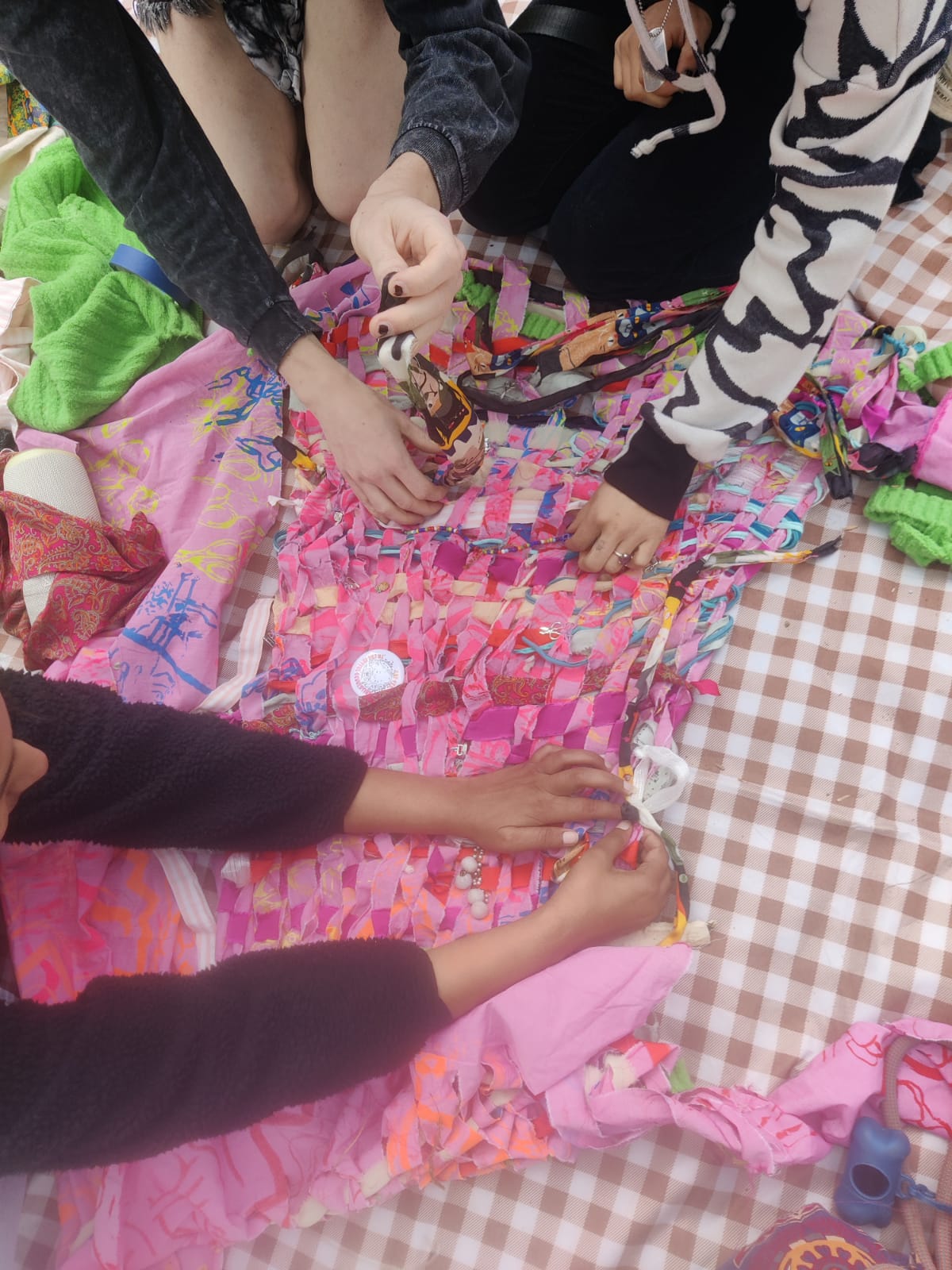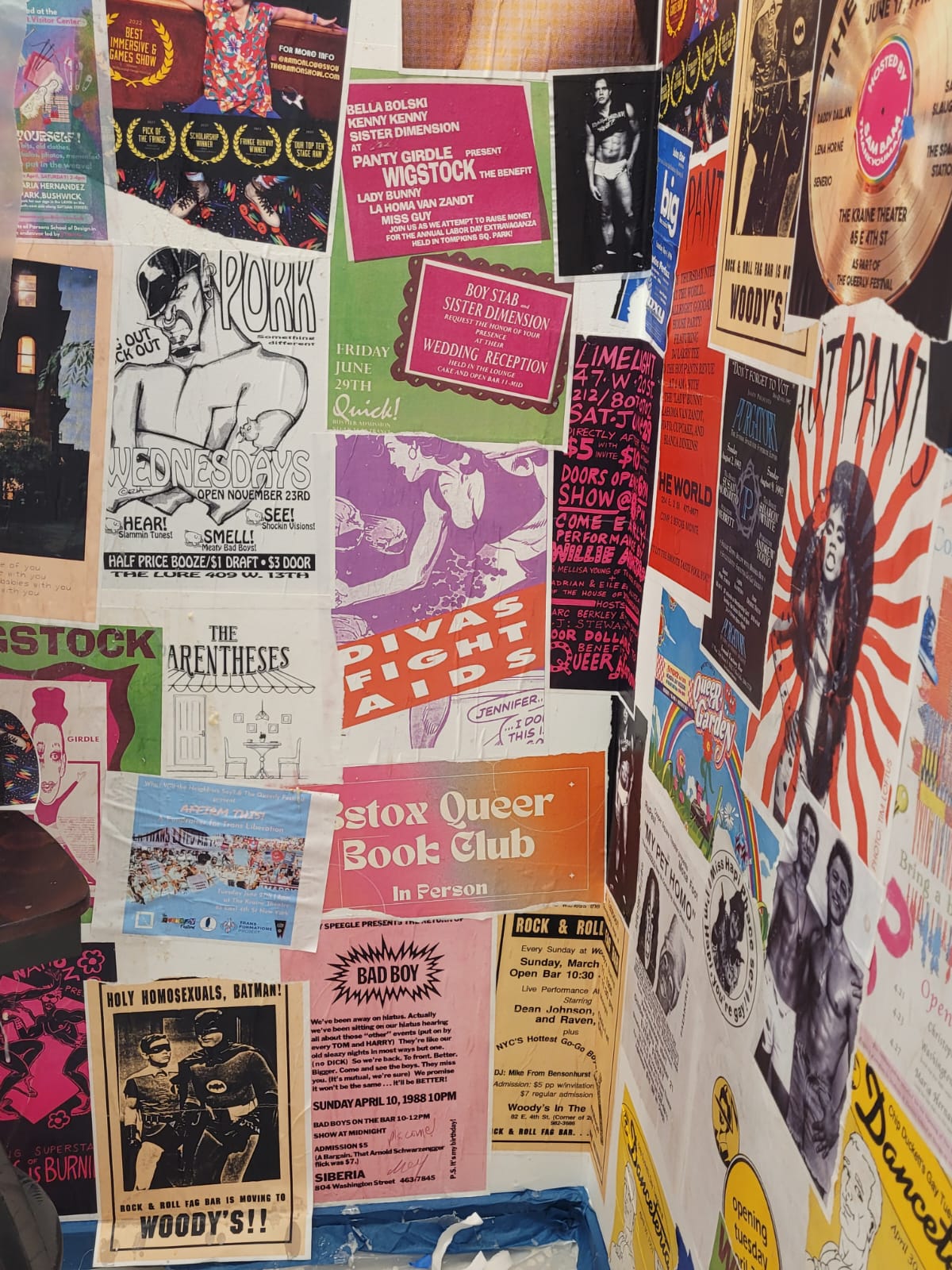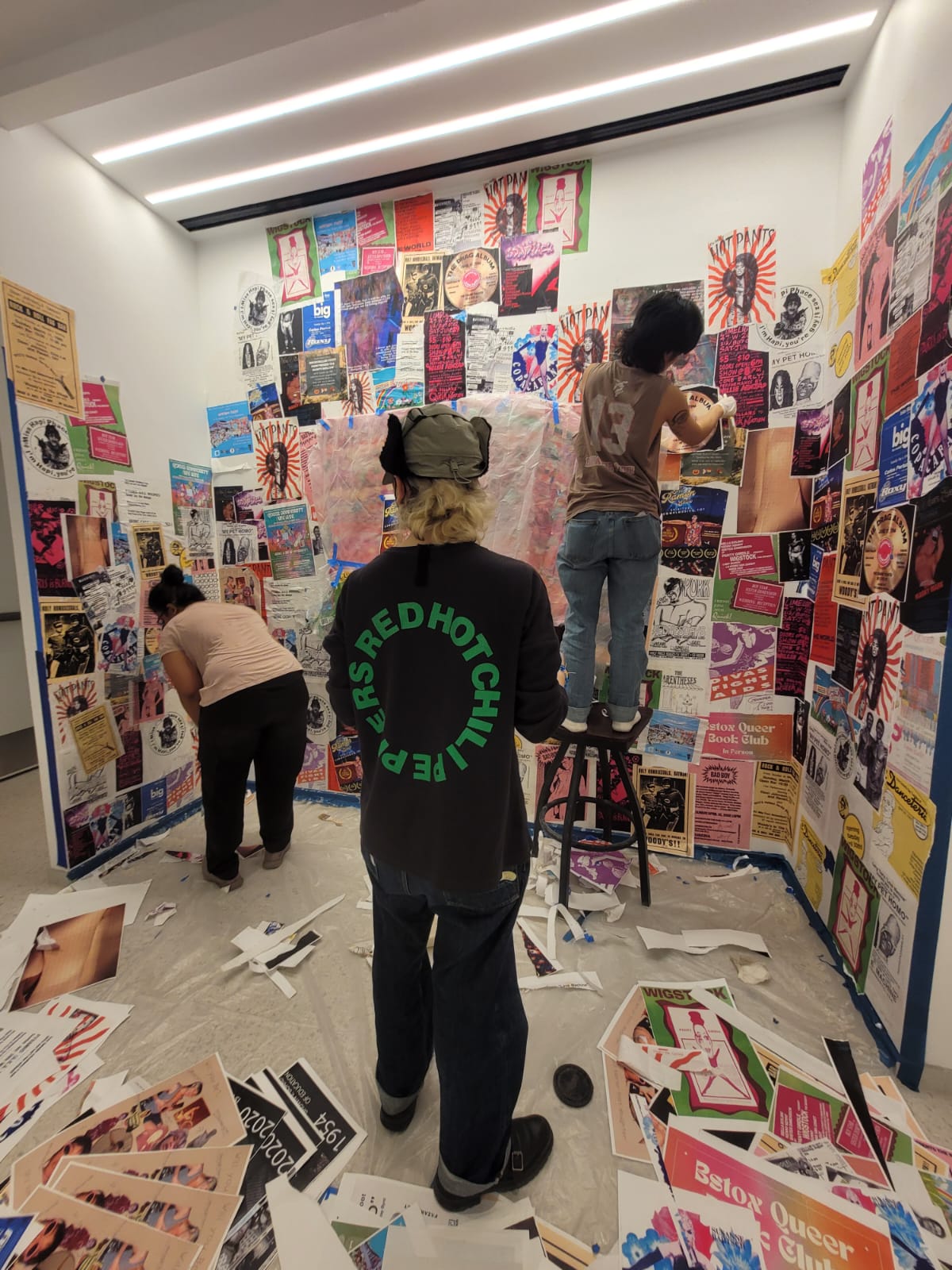
(WE)AVE MADE HISTORY
An interactive installation for the Stonewall National Monument Visitor Center exploring collective memory and queer history
Project Overview
Timeline
January - June 2024
Client
Pride Live / Stonewall National Monument Visitor Center
Skills
Research, Visual Design, Lighting Design, Installation, Community Engagement
Team
5-person team from Parsons School of Design
Visitors
Serving 1.58M annual visitors
Participated in weaving sessions, contributing personal stories and artifacts
Creating a multi-layered visitor experience that became the most popular attraction
Co-curated and designed for the collage wall
Facilitated to gather community input and stories
This project, installed at the Stonewall National Monument Visitors Center, was a collaboration between the Live Exhibits class at Parsons School of Design and Pride Live. My peers and I embraced the challenge of exploring the multifaceted and politicized aspects of queer history. Central to our mission was the question: How do our narratives about the Stonewall Rebellion shape the future of queer liberation? Additionally, we aimed to address whose histories are emphasized and who remains overlooked. By broadening the scope beyond Stonewall, this installation seeks to honor a more inclusive range of queer voices and stories.
My Role & Contributions
As a key member of a five-person Parsons School of Design team chosen to develop an exhibit for the SNMVC in collaboration with Pride Live, I contributed significantly to creating what became the most popular attraction serving 1.58M annual visitors.
Exhibition Wall Curation & Design
Co-curated and co-designed the layout for a 100+ poster exhibition wall, including creating original posters via InDesign. This visual collection represented the diverse history of queer spaces and became a focal point for visitor engagement.
Lighting & Visual Design Leadership
Co-led lighting design and contributed to visual design and copywriting for 15+ print materials, including journal covers and flyers designed with a 48-hour turnaround for engagement sessions. This work established a cohesive visual language that enhanced the visitor experience.
Research & Community Engagement
Interpreted the legacy of the Stonewall Riots through research, outreach, and facilitation of three public engagement sessions. These sessions were crucial for gathering community input and ensuring the installation represented diverse perspectives.


Project Highlights
- Rapid Turnaround: Created essential materials within tight 48-hour deadlines to support community engagement initiatives
- Visual Impact: Designed original posters that became integral components of the exhibition wall
- Technical Integration: Successfully blended lighting design with spatial elements to create an immersive environment
- Community Connection: Facilitated meaningful workshops that directly informed the final installation
Concept
Our project "(WE)AVE MADE HISTORY" celebrates the rich tapestry of LGBTQ+ history and community beyond the conventional narrative of Stonewall as the sole birthplace of the queer movement. We recognized that focusing on a single narrative invariably excludes a broad array of personal histories. Our wall installation aims to create a safe space for different queer voices to emerge through several interactive elements:
The collective weave — A communal practice allowing visitors to leave a physical piece of themselves behind
Journals — Private spaces for personal stories on a less public level
Collage wall — A visual landscape for queer voices through historical and fabricated posters that visitors can add to
Rest space — An invitation for visitors to pause, reflect, and place themselves within the greater history


Design Process
Our design process was driven by four key frameworks that guided our approach:
Histories & Politics of Queer Liberation
The queer community is not immune to its own exclusivities. Those at the center of early queer liberation movements — trans people, people of color, and working-class LGBTQ+ people — continue to struggle for representation and visibility. We asked: Under which lens is queer history being told? Who is queer liberation for? By expanding the definition of Pride, we aimed to bring visibility to queer history outside of and beyond the Stonewall riots.
Queer Intimacy & Rest
Queer intimacy and rest draws from a larger movement centering rest as a means of resistance. Resisting capitalistic demands of productivity and taking a moment to stand still is a radical act of existence. Centering queer intimacy and rest is part of a concerted effort to reclaim the right to rest, contemplation, and intimacy that has been denied to LGBTQ+ people the world over.
Regeneration
Regeneration is a critical lens recentering and reenergizing queer life by showcasing activist causes within the community. It's also wordplay: Re:Generation refers to a concerted effort to transfer queer knowledge to younger generations, paving a way forward.
Collective Weaving
Collective weaving is both a methodology to organize fragmented histories and a form of communitarian co-creation where friction and conflict are translated into the process of becoming a "We." The internal contradictions and discrepancies behind the "we" in queer history are honored through this process.
Our design process was guided by three core objectives:
- Visually showcase our interconnectivity and rich history
- Provide a place for rest, comfort, safety, and reflection
- Create an environment where visitors can actively feel the everpresent queer spirit
![]()
![]()
![]()
The Final Outcome



The final installation creates a layered experience where visitors can engage with queer history through multiple entry points:
The Collective Weave - Incorporating elements from the Re:Generations framework, the textiles created by our class formed the base material for our community weave. This reconstruction physically intertwines our class's past history alongside the greater community, symbolically denoting the interconnectedness of personal queer histories.
The Journals - Handmade journals with prompts along their spines invite visitors to add personal responses. They function as both guest books for the installation and archival objects documenting the lives, experiences, and opinions of queer people in the present moment.
The Open Collage - A vibrant wall pays homage to diverse queer spaces that have flourished in New York City, showcasing posters, event flyers, and memorabilia that adorned their walls. This immersive experience educates visitors on the breadth of queer culture while recreating the authentic ambiance of queer social spaces.
Lighting Design - Strategic use of colored lighting recreates the vibrant and inclusive ambiance of queer spaces, enhancing the emotional experience while paying homage to the visual language often found in LGBTQ+ venues.

Feedback
Collaboration and Teamwork
This project was made possible through the collaborative efforts of our diverse team from Parsons School of Design, working in partnership with Pride Live. Our team brought together students from various disciplines, including Interior Design, Fashion Design, Design and Technology, and Strategic Design Management.
Diana Rodriguez, founder of Pride Live, initially reached out to Parsons Architecture Program after noticing a lack of young voices in SNMVC planning meetings. This partnership aimed to engage students with the legacy of the Stonewall Rebellion and queer resistance.
Our cohort built upon the work of the inaugural exhibition from 2023, which established the "REGENERATIONS" framework that guided our approach. We worked under the guidance of Professor Alfred Zollinger, collaborating across disciplines to bring different perspectives to the project.
Collaborative Framework
Our team established a horizontal collaboration structure with specialized sub-teams that allowed us to work efficiently while maintaining a cohesive vision:
- Research Team: Historical investigation and framework development
- Design Team: Visual language, materials, and spatial configuration
- Community Team: Workshop planning and community engagement
- Production Team: Implementation, installation, and documentation
Weekly full-team critiques ensured alignment, while daily check-ins within sub-teams maintained momentum. This structure enabled us to leverage individual strengths while creating a unified installation.

Project Timeline
Project Initiation
The project began with an introduction to the SNMVC space and initial client meetings with Pride Live. Our team conducted preliminary research on queer history and the significance of the Stonewall National Monument.
Concept Development
This phase focused on exploring various conceptual directions and establishing our framework based on collective weaving as a metaphor for queer history.
Design Development
With our concept established, we moved into detailed design development, creating prototypes and testing various elements of the installation.
Community Engagement
We held several community weaving sessions to gather input, test our concepts, and begin creating the core material for the installation.
Production & Refinement
This phase involved finalizing all elements of the installation and preparing for installation.
Installation & Launch
The culmination of our work involved installation at the Stonewall National Monument Visitor Center and opening to the public.
Budget & Resources
Our project leveraged a combination of institutional support, community contributions, and careful resource allocation to create a meaningful installation within budget constraints.
Budget Allocation
Resource Partners
Institutional Support
- Parsons School of Design (workspace, equipment)
- Pride Live (venue, promotional support)
- The New School Libraries (research resources)
In-Kind Donations
- Fabric and textile donations from local businesses
- Professional lighting consultation
Project Presentation
Below is our comprehensive project presentation that outlines our research, concept development, design elements, and implementation plan for the Stonewall National Monument Visitor Center installation.
This presentation was delivered to Pride Live representatives and project stakeholders, highlighting our design framework, material choices, and installation strategy. The document showcases our thoughtful approach to representing diverse queer histories while creating an interactive and engaging visitor experience.
Reflection
Working on the Stonewall National Monument Visitor Center project was a profound experience that allowed me to contribute to preserving and expanding queer history. Through this collaborative process, I gained valuable skills in exhibit design, community engagement, and creating meaningful interactive experiences.
The most significant takeaway was our success in transcending the typical historical exhibit format. Rather than simply commemorating past events, we created a living installation that effectively captures the stories of queer people today and their allies. This transformation from retrospective to contemporary relevance represents the project's most powerful achievement.
The weaving metaphor that guided our project became a powerful conceptual framework—showing how individual stories, experiences, and histories can come together to create something stronger and more beautiful than their individual parts, while still maintaining their unique characteristics. By inviting current visitors to contribute, we ensured the installation remains dynamic and evolving, reflecting the ongoing nature of queer history rather than freezing it in the past.
This project reinforced my belief in design's power to create dialogue, foster community connection, and make history accessible to new generations. I'm proud to have been part of a team that approached this responsibility with care, creativity, and commitment to amplifying marginalized voices within queer history—both historical and contemporary.
Key Learnings
- Community-Centered Design: The value of placing community needs and voices at the center of the design process rather than imposing a predetermined vision.
- Interdisciplinary Collaboration: How diverse perspectives strengthen design outcomes and create more nuanced, thoughtful solutions.
- Interactive Storytelling: Techniques for creating participatory experiences that engage visitors as active contributors rather than passive observers.
- Material Narratives: How material choices themselves can communicate meaning and contribute to the storytelling.
- Sustainable Engagement: Designing systems that continue to evolve and engage without requiring constant maintenance.